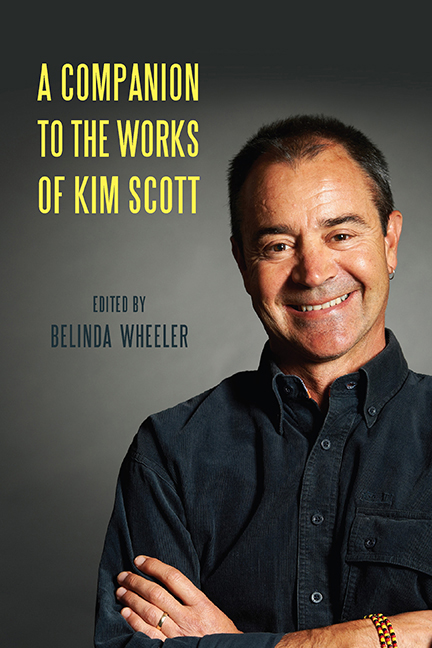Book contents
- Frontmatter
- Contents
- Foreword
- Acknowledgments
- Note on Orthography
- Chronology of Key Writings
- Introduction
- 1 Kim Scott’s Publishing History in Three Contexts: Australian Aboriginal, National, and International
- 2 Kim Scott’s True Country as Aboriginal Bildungsroman
- 3 The Land Holds All Things: Kim Scott’s Benang—A Guide to Postcolonial Spatiality
- 4 Kim Scott’s Kayang and Me: Noongar Identity and Evidence of Connection to Country
- 5 “Wreck/Con/Silly/Nation”: Mimicry, Strategic Essentialism, and the “Friendly Frontier” in Kim Scott’s That Deadman Dance
- 6 The International Reception of Kim Scott’s Works: A Case Study Featuring Benang
- 7 Traumatic Landscapes: Inscribing Spectrality and Identity in Kim Scott’s “A Refreshing Sleep,” “Capture,” and “An Intimate Act”
- 8 Spatial Poetics and the Uses of Ekphrasis in Kim Scott’s “Into the Light” and Other Stories
- 9 The Poetry of Kim Scott
- 10 The Wirlomin Project and Kim Scott: Empowering Regional Narratives in a Globalized World of Literature
- 11 Kim Scott as Boundary Rider: Exploring Possibilities and New Frontiers in Aboriginal Health
- 12 An Interview with Kim Scott
- Notes on the Contributors
- Index
9 - The Poetry of Kim Scott
Published online by Cambridge University Press: 08 May 2021
- Frontmatter
- Contents
- Foreword
- Acknowledgments
- Note on Orthography
- Chronology of Key Writings
- Introduction
- 1 Kim Scott’s Publishing History in Three Contexts: Australian Aboriginal, National, and International
- 2 Kim Scott’s True Country as Aboriginal Bildungsroman
- 3 The Land Holds All Things: Kim Scott’s Benang—A Guide to Postcolonial Spatiality
- 4 Kim Scott’s Kayang and Me: Noongar Identity and Evidence of Connection to Country
- 5 “Wreck/Con/Silly/Nation”: Mimicry, Strategic Essentialism, and the “Friendly Frontier” in Kim Scott’s That Deadman Dance
- 6 The International Reception of Kim Scott’s Works: A Case Study Featuring Benang
- 7 Traumatic Landscapes: Inscribing Spectrality and Identity in Kim Scott’s “A Refreshing Sleep,” “Capture,” and “An Intimate Act”
- 8 Spatial Poetics and the Uses of Ekphrasis in Kim Scott’s “Into the Light” and Other Stories
- 9 The Poetry of Kim Scott
- 10 The Wirlomin Project and Kim Scott: Empowering Regional Narratives in a Globalized World of Literature
- 11 Kim Scott as Boundary Rider: Exploring Possibilities and New Frontiers in Aboriginal Health
- 12 An Interview with Kim Scott
- Notes on the Contributors
- Index
Summary
KIM SCOTT IS NOT generally known as a poet. His literary reputation is built on a sequence of novels—True Country (1993), Benang: From the Heart (1999), and That Deadman Dance (2010)—the last two of which won the Miles Franklin Literary Award. He is also known for his sincere and, at times, searing work in reconnecting with his own Noongar extended family and kinship group, and the regeneration of the Noongar language through grassroots work with Noongar people from the south coast of Western Australia. Scott's poems are relatively few in number—few enough for close analysis— but are significant for the simple fact that they were the first literary works that he published and an important part of his literary formation.
Scott's first poems were published in journals associated with the Fremantle Arts Centre. The Fremantle Arts Centre was founded in 1972 by the poet and art teacher Ian Templeman and quickly became a lively regional hub for community arts. In 1976, Templeman created the Fremantle Arts Centre Press (called the Fremantle Press since 2007), which became the premier Western Australian literary publisher and a major force in regional publishing in Australia more generally, launching the careers of writers like Elizabeth Jolley, A. B. Facey, Sally Morgan, John Kinsella, and Scott. In 1974, two years prior to the launch of the press, Templeman had started a poetry magazine called Patterns, published by the Arts Centre. It was in Patterns that Scott first appeared in print in 1985 with a poem entitled “In Perspective.”
we walked along the railway
One dune behind and parallel to the beach.
We balanced on a line, one on each,
And saw we’d meet, as perspective, proper, told us.
Between us and the dune, a fence.
Barbed wire, rusted, chopped up our view
That was of dune only, sand blank and scraggled.
A gull rose above the close horizon
Rolled its lidless eye, and dipped.
We stayed fenced.
Later, I photo’d myself distorted
Staring back, one eyed, from the lens of your mirror
Glasses.
We snapped ourselves, each in the eye of
The other
And moved further and further, furtherApart- Type
- Chapter
- Information
- A Companion to the Works of Kim Scott , pp. 114 - 129Publisher: Boydell & BrewerPrint publication year: 2016

